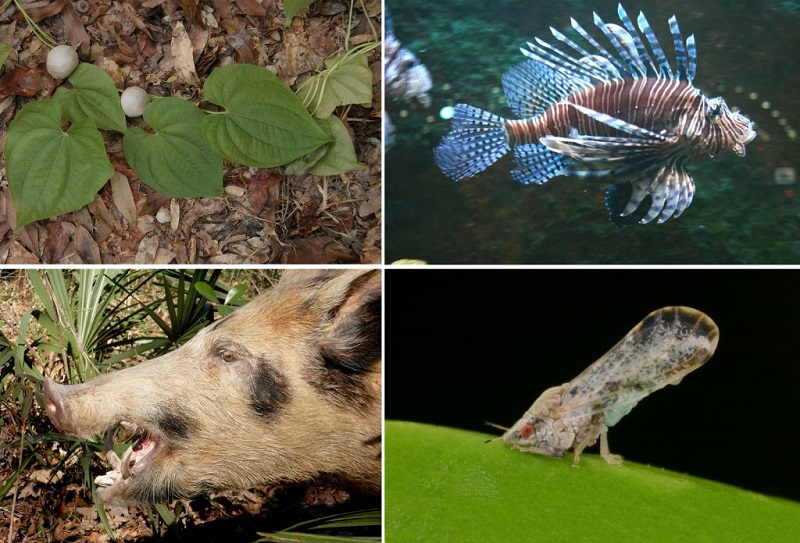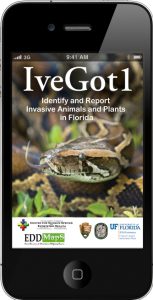February 20 – 26 is National Invasive Species Awareness Week, and UF/IFAS Extension agents throughout Florida have been raising awareness about invasive species and how we can limit their impact on our state’s economy, our natural ecosystems and our everyday lives.
If you happen to see what looks like a baby dragon walking on water, could you please give your local wildlife Extension specialist a call? Chances are, it’s a brown basilisk, and it might possibly be Florida’s next invasive species threat.
The brown basilisk lizard is six inches long, brown or dark olive in color, with yellow or cream-colored stripes running down its sides. Its head has a fin-like, backward sweeping crest, like a dragon (or a parasaurolophus, if you’re a dinosaur fan). These lizards have long, strong rear legs that can carry them swiftly over distances. In fact, brown basilisks are so fast they can even run across the surface of the water.
They’re not from around here. Brown basilisks are native to lowlands in Mexico and Central America. They were first introduced to Florida about 60 years ago through the pet trade. A few people bought these exotic lizards for their terrariums and they escaped. Maybe they scurried across swimming pools into the woods. Facing little resistance from native predators, they met up and formed small, sustained populations feeding on grasshoppers and caterpillars. In other words, they became established, primarily in South Florida.
Now people are finding them in other areas, from the Florida Keys to Gainesville.
Brown basilisks are not considered invasive–yet. An invasive species is a nonnative species that causes, or is likely to cause, environmental, human or economic harm. There are many unanswered questions about the impacts of brown basilisks in Florida. Are they preying on native species or outcompeting natives for food or other resources? Are they damaging crops and human structures? There are questions about their invasiveness potential — for example, they may serve as an attractive host to Culex mosquitoes, which transmit West Nile Virus. That has scientists concerned enough to want to know more about brown basilisks and their impact on Florida’s natural areas.
Because when it comes to managing invasive species, it’s all about early detection and rapid response.
Invasive plants, animals and pathogens cause an estimated $179 million in agricultural losses in Florida each year. Our local news stories frequently feature Burmese pythons that wreak havoc in the Everglades, hydrilla that clog our waterways, lionfish that depopulate marine ecosystems, lygodium that create fire hazards in our forests, and psyllids that spread citrus greening disease across our orange groves. The problem is that once an invasive species gets famous enough to be on the news, it’s often too late to eradicate, and mitigating its impact becomes exponentially more difficult and expensive. In order to keep invasive species under control, we need to find the outliers early and respond immediately if they pose a threat.

That’s why wildlife specialists with UF/IFAS and other groups are keeping a close eye on nonnative species–and they can use help from sharp-eyed citizen scientists like you.
EDDMapS–the Early Detection and Distribution Mapping System–is a web-based mapping system for documenting invasive species and pest distribution. EDDMapS aggregates data from other databases and organizations, as well as volunteer observations to create a national network of invasive species data that is shared with educators, land managers, conservation biologists, and others. There are over 7.5 million records on EDDMapS, each gradually adding knowledge about the distribution of nonnative and invasive species.
By downloading the IveGot1 app to your mobile device, you can take photos of brown basilisks or any other species of plant or animal you think might be nonnative and upload them to the EDDMapS database. The app automatically records your GPS data, and the photos are reviewed by specialists before it appears on maps to ensure all data is accurate. IveGot1 is also a great tool for identifying and learning about the invasive and nonnative species in your area.
Only time will tell whether the brown basilisk remains a harmless nonnative or becomes reclassified as a destructive invasive. But it will take close observation from scientists and citizen scientists like you to determine the range and impact of brown basilisk and other nonnative species in our state.
To learn more about Florida’s invasive species, visit the UF/IFAS Invasive Species Council website at https://invasivespecies.ifas.ufl.edu
 0
0

